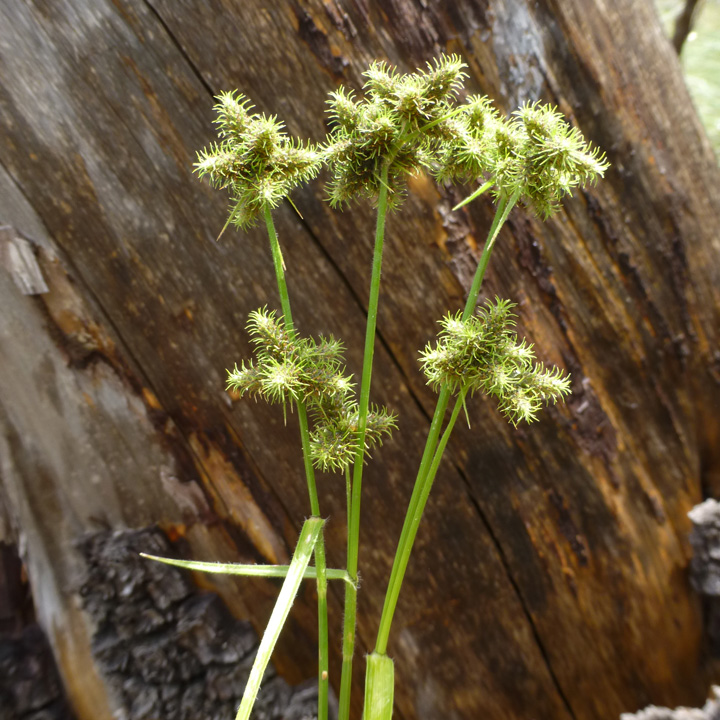Herbs, annual or perennial, cespitose or not, rhizomatous or not, variously pubescent. Culms solitary or not, 3-5-angled in cross section. Leaves all cauline, polystichous, usually hairy, hair sometimes confined to junction of blade and sheath; sheaths closed, tubular; ligules tubular, scarious; blades sometimes absent or reduced to mucro or cusp, flat, or those mid culm strongly formed. Inflorescences of spikelets sessile in clusters of 2-5 (rarely solitary), the clusters sessile or pedunculate and terminal or racemose; spikelets to 150. Spikelets: scales 20-50, spirally arranged, proximal 1-2 scales empty, others subtending flower, some distal scales empty. Flowers bisexual; perianth (3-)6 in sets of 3, outer set of stout, sharp bristles shorter than inner set of stipitate-bladed, spatulate scales, rarely inner set forked or pinnately lobed; stamens 1-3(-6), long-exserted; styles linear, 3-fid, articulate well distal to base, base usually persistent. Achenes trigonous-rhomboid.
Nearly all species are heliophytic wetland plants.
Rhizomes of the fuirenas are compact to elongate. Culms arise directly from rhizomes or from short, fleshy, cormlike shoot buds; they are cespitose or lined along rhizome, erect to sprawling, grooved or sharply angled, variously ribbed, stiff or flaccid, and smooth except in the inflorescence. Most proximal nodes are usually widely spaced, producing the largest bracteal leaf and longest peduncle. Internodes and bracts are progressively shorter on distal culm. Leaf sheaths are strong and many ribbed; ligule and contraligule are connate to form a short, oblique or truncate, ciliate tube. If midculm leaf blades are formed, they are variously linear, the base cordate-clasping, margins variously thickened or not, and the apex narrowly acute and often hirsute-ciliate. Inflorescences are green, green-brown, or red-brown, mostly sessile, ovoid, ellipsoid, or lance-cylindric, mostly 1-2 cm. Flowers are mostly 2.5-3.5 mm, excluding long-exserted stamens; filaments slender, flattened; anthers erect, 2-locular, oblong-linear; ovary 3-carpellate; styles elongate, filiform, hispidulous. Achenes are usually prominently stipitate, angles wirelike, 1 mm, faces smooth to finely reticulate, apex usually peglike, erect, linear, slightly dilated, stiff, papillose-hispidulous; beak rarely present, short-triangular.
Fuirena wallichiana, an Asian species, has been found in the flora only once, in wet areas of chrome ore piles at Newport News, Warwich County, Virginia, by Clyde F. Reed (PH!). It is cited here as a chance introduction whose continuance in a unique habitat should be monitored. It is included in the key to facilitate identification; it is not included in the species count.
Scales numerous, spirally arranged, usually hairy, with an often spreading or recurved awn or mucro, the lowest 1-3 empty; fls perfect, with 1-3 stamens and trifid style; ovary subtended by 3 bristles alternating with 3 perianth-scales ("petals"), the latter long- stipitate, with expanded blade, often awned; achenes trigonous, long-stipitate, beaked-apiculate; leafy- stemmed sedges with strongly veined sheaths, ours with a few spikelets in a terminal head subtended by 2 or 3 ±foliaceous bracts, often with some additional pedunculate axillary clusters. 30, warm reg.
Gleason, Henry A. & Cronquist, Arthur J. 1991. Manual of vascular plants of northeastern United States and adjacent Canada. lxxv + 910 pp.
©The New York Botanical Garden. All rights reserved. Used by permission.





